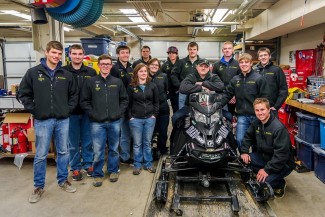Idaho Clean Snowmobile Team stands out at international competition
While most students spent the beginning of March enjoying an early spring in Moscow, members of the University of Idaho Clean Snowmobile Team spent their week baring the cold and snow of Houghton, Michigan, to compete in the SAE International Snowmobile Challenge.
Mark Woodland, a second-year member of the team, said UI was awarded the Bill Paddleford Memorial Award for Most Sportsmanlike Conduct and placed fifth overall in the competition.
“We did really well for what happened to us,” Woodland said. “We ran into engine troubles, there was some soot build up that resulted in problematic emission levels.”

College of Engineering | Courtesy
The College of Engineering Clean Snowmobile Team members stand around their creation.
Patton said UI’s snowmobile team has consistently performed well over 15 years of competition and has even placed first three different times.
The week-long competition, which began March 2, involved a number of events, including an emission-testing event, a speed test and a 100-mile endurance race.
According to Rob Patton, spokesperson for the College of Engineering, this year’s competition included 22 teams as well as competitors from Finland and Canada.
Patton said the competition, originally held in Wyoming, first began in 2000 and was the result of national parks resolving to allow snowmobiles on their grounds.
“Parks like Yellowstone began using snowmobiles and they started to recognize there were some issues,” he said. “The snowmobiles were noisy, not very fuel efficient and tended to get stuck on difficult terrain.”
It was from the need to improve these issues that the competition was first born, Patton said. He said those three problems became the primary components of the snowmobile challenge.
“The competition challenges students to take a stock snowmobile and modify it,” Patton said. “All of the challenges test the noise level, fuel efficiency and overall performance of the vehicle.”
Patton said UI’s snowmobile featured a number of new technologies, including a device to reduce noise and a wire system to make the vehicle more efficient.
“The team created an echo cancellation device that they connect to their exhaust system and it cuts the noise in half,” Patton said. “They also developed a new way of creating a throttle that talks to the engine to improve on their efficiency.”
Patton said while the UI team receives partial funds from the College of Engineering, the majority of its funding comes from private sponsors.
“Money plays a big role in the competition, and UI’s team does an amazing job with very little resources,” Patton said. “These are students who are creating solutions that have never been done before.”
Zachary Lipple, a freshman member and mechanical engineering major, first heard about the team through his academic advisor.
Lipple said preparation for the competition started out slow, but as the academic year went on, building a snowmobile became rigorous work.
“In the beginning, we all started out on different projects,” Lipple said. “As the year moved on, we really started working together and functioned like a well-oiled machine.”
Lipple said the team worked well together because there were a variety of components involved in building the snowmobile and each team member had their own niche.
“The team is very inclusive, but everyone usually sections off work based on what they enjoy most,” Lipple said. “For example, I’m best at computational fluid dynamics and tunnel efficiency so that’s mostly what I worked on.”
Woodland said preparing for the competition involved long hours and a lot of strenuous work.
“We start with a stock snowmobile and then go about this extensive process,” he said. “We design modifications through computer programs, machine them, test them, redesign them and this happens over and over again until we come up with a quieter, more efficient product.”
Woodland said the most difficult aspects of preparing for the competition included finding a balance between school and working on the snowmobile, testing the vehicle and the redesigning process.
“There’s a big time restraint because we work on the machine between classes,” Woodland said. “It can also be fickle while testing sometimes — one day a part can be working just fine and the next day it’s useless.”
Despite the long hours and high standards of competition, both Lipple and Woodland said the team and the experience make all of their hard work worth it.
“The competition is the smartest place I’ve ever been,” Lipple said. “You’re surrounded by engineering majors, engineering industries, all of these amazing minds just together in one place doing what they love … It’s unbelievable.”
Corrin Bond can be reached at [email protected]
